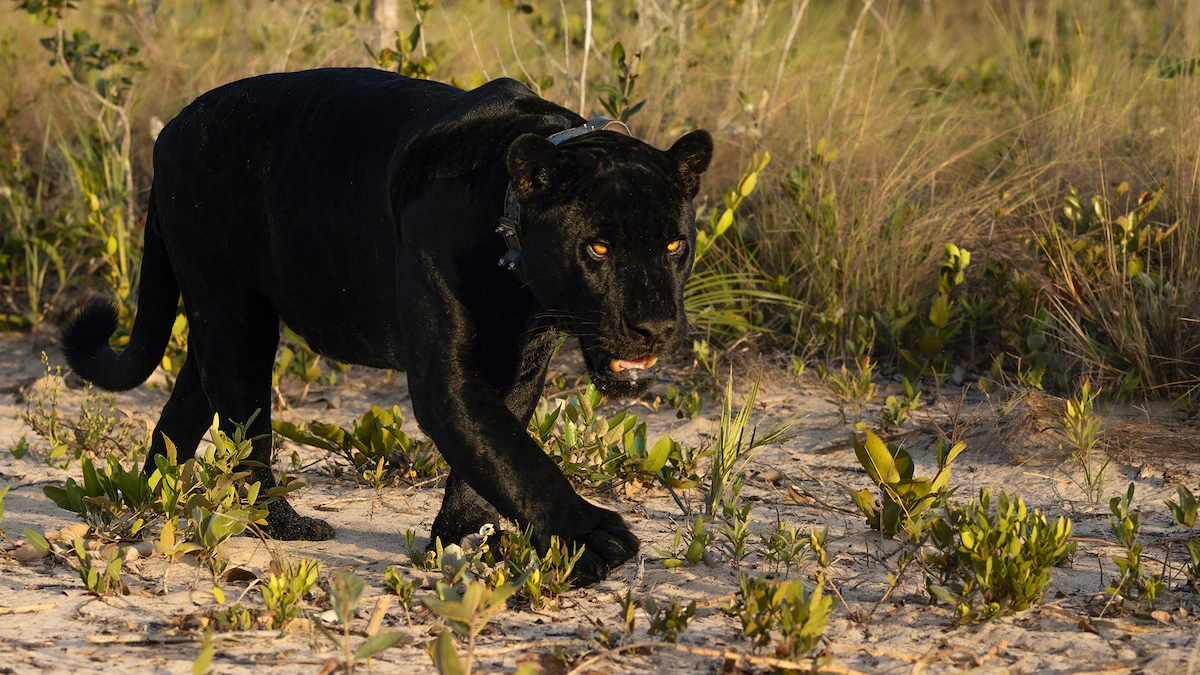
I’m face to face with a black jaguar. With the unhurried, nonchalant gait of a predator at the top of its food chain, the feline ambles closer to our quad bike, which we parked at a distance along a dirt path. It’s about to overtake us, then halts so close we could reach it in three strides, turns as if in slow motion and meets our stares. Eyes this yellow can be one of two things: a warning; or a lure, tempting as a honeytrap, damning as light to a moth.
“I’ll never tire of this,” whispers Eduardo ‘Edu’ Fragoso from the driver’s seat, wearing wraparound glasses to shield himself from the sun of the Cerrado, a savannah stretching across much of central Brazil. He’s a coordinator at Onçafari, a nonprofit pioneer of safari drives in the country, which operates here out of Pousada Trijunção, a lodge set in over 125sq miles of protected land. Edu and his team have been observing the local big cat population for two years, with the aim of offering jaguar-spotting tours by 2027, and they’ve taken me on a research trip. “It’s rare,” he says as the animal walks on, following the thick vegetation lining the road, “seeing it so close and clearly.”
The best place to find jaguars in the wild is widely believed to be the Pantanal, a wetland far to the west, but there are benefits to coming here instead. On average, around 10% of the species is melanistic (black-coated); in the Cerrado, the incidence is over 40%, the highest in any region. “We don’t know why,” says Edu. “We’re trying to answer the question.”Proceeds from Onçafari’s safari drives support its research, including conservation projects like this one. “We know the power of a black jaguar — the icon, the myth,” continues Edu. “We’re using it to save them.”
South America’s second-largest biome, the Cerrado covers over 775,000sq miles, which is almost four times the size of France. Since the 1970s, it’s been turned into an agricultural behemoth, with encroaching monoculture plantations and mammoth irrigation systems that leech the soil dry. More than half of both its primary vegetation and jaguar population have been lost. “It’s the most devastated part of the country,” says Edu.
His team’s main goal is habitat connectivity in the Mosaico Sertão Veredas-Peruaçu, a group of 38 protected areas — including Pousada Trijunção and the adjacent Grande Sertão Veredas National Park — across some 11,500sq miles. “We work with the environmental agency to prove the importance of wildlife corridors,” says Edu. Take the animal in front of us: its home range is almost 1,900sq miles, the largest recorded for the species, and over 70% of that lies outside protected land. “He can’t find what he needs. And if it’s true for one, it’s true for many.”
The slanted, late-afternoon light outlines the silhouette of the jaguar, now distant again. Its jaw, which gives the most powerful bite of any big cat; the curve of the leg, which allows it to sprint as fast as 50mph and jump as high as 10 feet. But here, too, is an animal panting in the heat, dragging its paws to shade — a king among creatures subject to the rule of nature, fast-changing around it. “I’ll leave him now,” says Edu, starting the quad bike. “He’s been kind to us. Let’s be kind to him.”
The upside-down forest
The word cerrado is Portuguese for ‘closed’, a name that captures what this land was once perceived to be: remote, unwelcoming, inhospitable. Even today, reaching its heart involves a five-hour drive from the capital, Brasília. Much of the ground is covered in tall grass, leather-tough shrubland and stunted trees. During the dry season, it can be more arid than the Sahara. But because of its location on the flat Brazilian Plateau, it’s also one of the most wide-open places you’re likely to come across. “These horizons are like nowhere in Brazil,” says Vinícius ‘Vini’ Vianna, an ornithologist at Pousada Trijunção, holding a pair of binoculars like a natural extension of his hands. “The sunsets are like Africa’s.
At night, the stars sweep 180 degrees in a full arc above.” We’re on a watchtower in the courtyard of the lodge for a sunrise birdwatching tour, taking in a panorama so expansive it spills out of the peripherals. “The Cerrado’s known as an ‘upside-down forest’,” Vini says, looking at the seemingly infinite expanse of low canopy. “The trees focus their energy downward to seek water. The roots can dig much, much deeper than the height of the branches.” Much of the Cerrado is not as first seems, and guests here learn about it on walking, kayaking and driving tours. Pretty calliandra flowers are believed to curse whoever picks them. Biting leaf-cutter ants are a much-loved food, and taste like lemongrass. A melancholic whistle in the night might be a potoo bird, a low buzzing a rattlesnake dove. For every secret uncovered, there’s a surprise coming.
“Wait — that’s a black jacobin hummingbird, a new species for the lodge,” says Vini, rushing for his camera to document the sighting. “Wow-ow-ow! You don’t know how happy I am right now.” When he started working here four years ago in 2021, the lodge had about 220 documented bird species; as of this morning, 309. The Cerrado has around 870 in total, as well as over 50,000 species of insects, mammals like giant anteaters and armadillos, and around 13,000 species of plants, 40% of which don’t exist anywhere else. It’s the most biodiverse savannah on Earth, home to around 5% of all species.
The best-known residents, aside from the jaguars, are maned wolves — large canines with sunburnt-orange fur, oversized ears and slender limbs that can reach three feet to the shoulders. “We call them ‘foxes on stilts’,” says Bruna Nunes, a researcher at Onçafari, that evening. She’s leaning halfway out of an open-sided 4WD to guide me on another safari drive, her own mane of curls wind-whipped. In fact, the animals are neither wolves nor foxes, not coyotes nor jackals; they’re alone in their genus, and have adapted to life in the Cerrado over three million years. “If humans tried to walk around here, they’d fight with the vegetation,” Bruna says, mimicking a person taking knee-high, awkward steps. “The wolf fits naturally.”
Aside from habitat loss, they suffer from the proximity to farmland, getting scabies from domestic dogs and being hit by cars. Onçafari’s been researching and raising awareness of threats to the species since 2016, and wolf-spotting is the company’s flagship experience in the Cerrado. Some of the animals have been fitted with tracking collars to facilitate studies and sightings, but finding them is still detective work, involving GPS data, VHF frequencies and drone images.
“Let’s see what we find,” says Bruna, angling a beeping antenna to intercept signals. “The Cerrado’s always a surprise.” We spot miniature crab-eating foxes and ostrich-like rheas. We pass a vereda, a word that means ‘path’ and is used here to describe belts of palm trees along rivers. Periodically, we stop when the signal gets stronger, scour the surrounds with a drone, think we’re nearing a wolf only for it to trot off and away again. “One thing we learned working with them is patience,” says Bruna after hours on the road, playing the ultimate game of hide and seek. “But also to have hope.”
And so it appears: on the path ahead, an animal like nothing I’ve seen, lithe and nimble, seeming to glide on dirt as if on air. “It walks like giraffes, moving the limbs on one side of the body at the same time,” says Bruna. “It makes it look like a model on a runway.” I look closely, wondering how an environment that was named for its perceived roughness could have helped create a creature of such grace. But all too soon, the wolf steps off the path and melts back into the wilderness, the thickets seeming to open and close for it. Looks like some of the Cerrado’s secrets are meant to stay that way.



